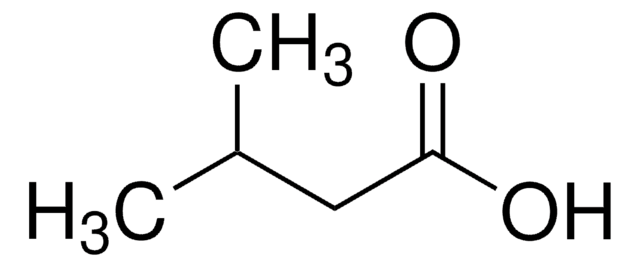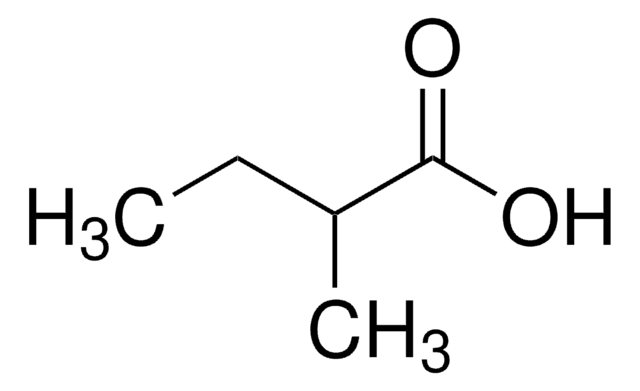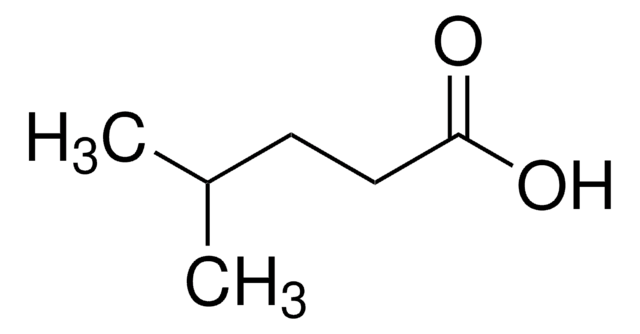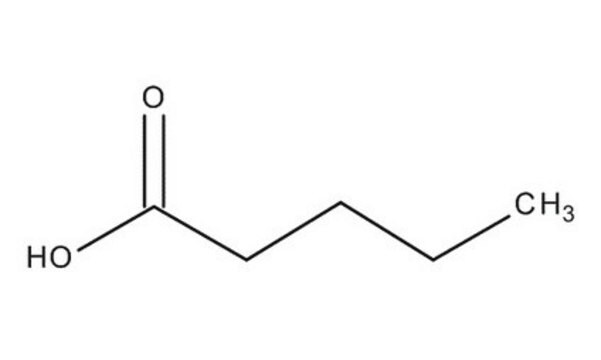75054
Valeric acid
analytical standard
Sinonimo/i:
n-Valeric acid, Pentanoic acid
About This Item
Prodotti consigliati
Grado
analytical standard
Livello qualitativo
Densità del vapore
3.5 (vs air)
Tensione di vapore
0.15 mmHg ( 20 °C)
Saggio
≥99.8% (GC)
Temp. autoaccensione
707 °F
Durata
limited shelf life, expiry date on the label
Limite di esplosione
7.6 %
tecniche
HPLC: suitable
gas chromatography (GC): suitable
Indice di rifrazione
n20/D 1.408 (lit.)
n20/D 1.408
Cerchi prodotti simili? Visita Guida al confronto tra prodotti
1 of 4
Questo articolo | W310107 | 240370 | W310162 |
|---|---|---|---|
| grade analytical standard | grade FG, Halal, Kosher | grade - | grade FG, Fragrance grade, Halal, Kosher, natural |
| format neat | format - | format - | format - |
| application(s) cleaning products | application(s) flavors and fragrances | application(s) - | application(s) flavors and fragrances |
| vapor density 3.5 (vs air) | vapor density 3.5 (vs air) | vapor density 3.5 (vs air) | vapor density 3.5 (vs air) |
| vapor pressure 0.15 mmHg ( 20 °C) | vapor pressure 0.15 mmHg ( 20 °C) | vapor pressure 0.15 mmHg ( 20 °C) | vapor pressure 0.15 mmHg ( 20 °C) |
Descrizione generale
Applicazioni
Avvertenze
Danger
Indicazioni di pericolo
Classi di pericolo
Aquatic Chronic 3 - Eye Dam. 1 - Skin Corr. 1B
Codice della classe di stoccaggio
8A - Combustible corrosive hazardous materials
Classe di pericolosità dell'acqua (WGK)
WGK 1
Punto d’infiammabilità (°F)
192.2 °F - closed cup
Punto d’infiammabilità (°C)
89 °C - closed cup
Dispositivi di protezione individuale
Faceshields, Gloves, Goggles, type ABEK (EN14387) respirator filter
Scegli una delle versioni più recenti:
Possiedi già questo prodotto?
I documenti relativi ai prodotti acquistati recentemente sono disponibili nell’Archivio dei documenti.
I clienti hanno visto anche
Articoli
Separation of Propionic acid; Acetic acid; Heptanoic acid; Isobutyric acid; Valeric acid; Isocaproic acid; Butyric acid; Isovaleric acid
Separation of Methyl oleate; Caprylic acid; Heptanoic acid; Methyl decanoate; Methyl dodecanoate; Myristic acid; Methyl palmitate; Methyl palmitoleate; Methyl stearate; Methyl linoleate; Methyl linolenate; Acetic acid; Arachidic acid; Behenic acid; Propionic acid; Isobutyric acid; Valeric acid; Isovaleric acid; Isocaproic acid; Butyric acid
Protocolli
In this study, SPME was used for the analysis of free fatty acids in Parmesan cheese using a 65 μm Carbowax/divinylbenzene (DVB) SPME fiber. Headspace extraction of the cheese sample was conducted at 65 °C for 15 minutes and analyzed by GC with FID detection. SPME is ideal for analyzing the volatiles associated with solid food samples. The phase chemistry of the Nukol GC column provides excellent peak shape of acidic compounds.
Il team dei nostri ricercatori vanta grande esperienza in tutte le aree della ricerca quali Life Science, scienza dei materiali, sintesi chimica, cromatografia, discipline analitiche, ecc..
Contatta l'Assistenza Tecnica.










